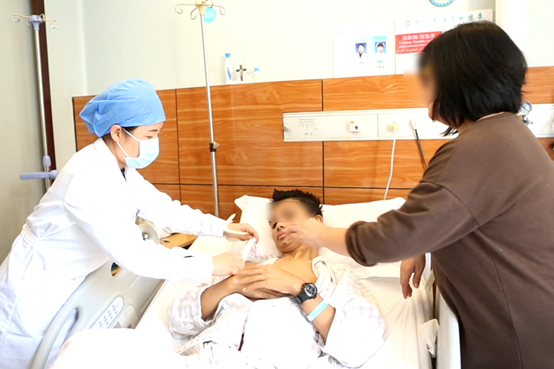When we met Lous (alias) again, his clear complexion and calm demeanor revealed his resilience, even as a hint of fatigue lingered. Comparing his appearance with records from five or six years ago, it was evident that the young boy had grown up, gained weight, and acquired a composed maturity. This was Lous’ 17th visit to Guangzhou Fuda Cancer Hospital, a place that had become familiar and comforting to him.

**22-year-old Lous**

**28-year-old Lous**
In 2017, Lous began experiencing intermittent pain in his right thigh. A checkup at a local hospital revealed a 13×10×11 cm mass in his right hip, suspected to be a vascular tumor or abscess. Over time, the pain extended to his bladder and abdomen, causing urinary difficulties and mobility issues. Tests confirmed the mass in his right hip and pelvic area was growing. In May 2018, a biopsy revealed spindle cell sarcoma with high differentiation.
Lous was just 22. Despite undergoing 33 sessions of radiotherapy and six cycles of chemotherapy, his condition deteriorated, and the pain became unbearable. Immunohistochemistry results confirmed rhabdomyosarcoma (RMS) in his right hip. Local doctors recommended surgery, but the tumor’s size and shape posed significant challenges and risks. His desperate parents searched for alternatives.
Upon a friend’s recommendation, they consulted Guangzhou Fuda Cancer Hospital’s Philippine office. They learned of a non-surgical treatment option, which offered a glimmer of hope. In December 2018, Lous and his family traveled to China and were admitted to Guangzhou Fuda Cancer Hospital.

A Multidisciplinary Approach
After thorough multidisciplinary team (MDT) consultations, Lous’ diagnosis of stage IV RMS with metastases to the pelvis and right iliac bone necessitated an aggressive yet cautious approach. Surgery combined with cryoablation was chosen to remove as much of the tumor as possible while preserving normal tissue. Post-surgery, pathology confirmed spindle cell sarcoma, consistent with RMS. Metastasis was evident in the right iliac bone.
From 2019 onward, Lous underwent multiple rounds of chemotherapy and targeted therapy. By the end of 2023, a local follow-up showed disease progression, prompting his return to Guangzhou in early 2024. His attending physician, Dr. Xing Yanli, identified new metastatic sites in the right iliac bone, liver capsule, and abdominal wall.
Although curative surgery was no longer an option, Lous underwent minimally invasive cryoablation for tumors in the liver capsule and abdominal wall, alongside biopsy procedures. Subsequent arterial infusion chemotherapy and targeted therapy further reduced tumor burden. Follow-ups showed a reduction in the size of metastatic tumors.

Gratitude and Determination
“It’s comforting to see familiar faces and be remembered even after so many years,” Lous shared. Initially anxious about the cultural and language barriers, as well as treatment outcomes in a foreign country, he was pleasantly surprised by the exceptional care and results. He expressed satisfaction with the medical expertise, attentive care, and follow-up services provided.
Despite the challenges of battling this rare type of cancer, Lous remains determined. He knows the road ahead is arduous, but his resolve to fight remains unwavering.
Know More About Sarcomas
Sarcomas, often referred to as “forgotten cancers,” are rare malignancies. Rhabdomyosarcoma (RMS) originates from cells that develop into skeletal muscles and can occur in various body parts, including the limbs, trunk, and head. It predominantly affects children and adolescents but can also occur in adults, where it tends to progress rapidly and be more challenging to treat.
While surgery is the primary treatment for RMS, it is rarely curative alone. A multidisciplinary approach, including advanced techniques like cryoablation, is essential. Cryoablation is particularly effective for bone metastases, offering simplicity, low recurrence rates, minimal pain, and quick recovery.
Early symptoms of RMS may include painful or painless lumps, skin redness, and elevated local skin temperature. Tumors in the nasal cavity can cause nasal obstruction or sinusitis, while those in the abdomen or pelvis may present with abdominal pain, vomiting, or constipation. Advanced stages may lead to symptoms like chronic cough, bone pain, lymphadenopathy, and weight loss.
Dr. Xing Yanli of Guangzhou Fuda Cancer Hospital emphasizes the importance of timely medical evaluation and checkups for suspicious symptoms. While no definitive prevention measures exist, avoiding harmful substances, boosting immunity, and regular health checkups are recommended.

